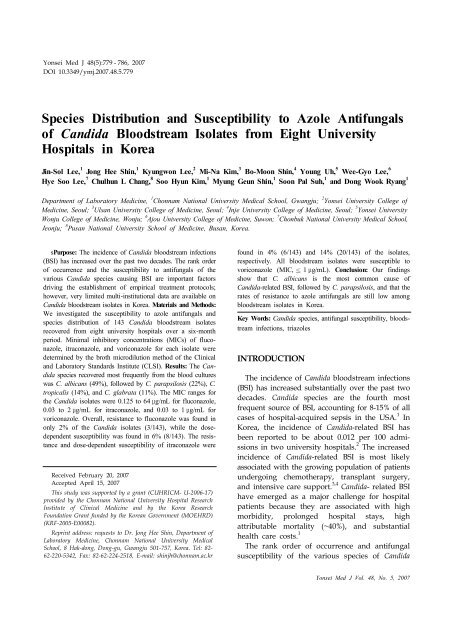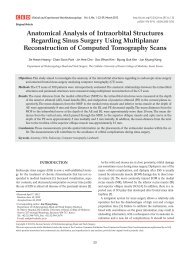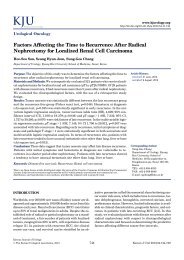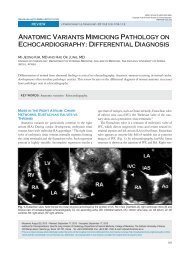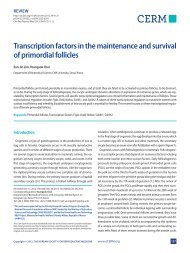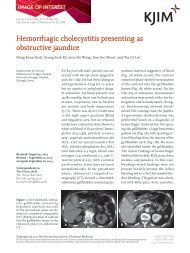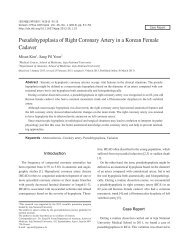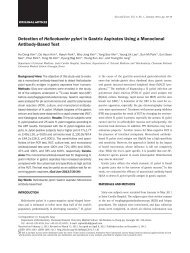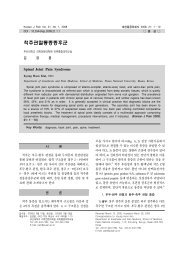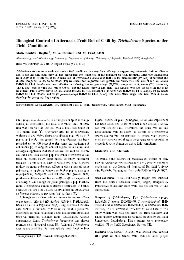Species Distribution and Susceptibility to Azole Antifungals of ...
Species Distribution and Susceptibility to Azole Antifungals of ...
Species Distribution and Susceptibility to Azole Antifungals of ...
Create successful ePaper yourself
Turn your PDF publications into a flip-book with our unique Google optimized e-Paper software.
Yonsei Med J 48(5):779 - 786, 2007<br />
DOI 10.3349/ymj.2007.48.5.779<br />
<strong>Species</strong> <strong>Distribution</strong> <strong>and</strong> <strong>Susceptibility</strong> <strong>to</strong> <strong>Azole</strong> <strong>Antifungals</strong><br />
<strong>of</strong> C<strong>and</strong>ida Bloodstream Isolates from Eight University<br />
Hospitals in Korea<br />
Jin-Sol Lee, 1 Jong Hee Shin, 1 Kyungwon Lee, 2 Mi-Na Kim, 3 Bo-Moon Shin, 4 Young Uh, 5 Wee-Gyo Lee, 6<br />
Hye Soo Lee, 7 Chulhun L Chang, 8 Soo Hyun Kim, 1 Myung Geun Shin, 1 Soon Pal Suh, 1 <strong>and</strong> Dong Wook Ryang 1<br />
Department <strong>of</strong> Labora<strong>to</strong>ry Medicine, 1 Chonnam National University Medical School, Gwangju; 2 Yonsei University College <strong>of</strong><br />
Medicine, Seoul; 3 Ulsan University College <strong>of</strong> Medicine, Seoul; 4 Inje University College <strong>of</strong> Medicine, Seoul; 5 Yonsei University<br />
Wonju College <strong>of</strong> Medicine, Wonju; 6 Ajou University College <strong>of</strong> Medicine, Suwon; 7 Chonbuk National University Medical School,<br />
Jeonju; 8 Pusan National University School <strong>of</strong> Medicine, Busan, Korea.<br />
sPurpose: The incidence <strong>of</strong> C<strong>and</strong>ida bloodstream infections<br />
(BSI) has increased over the past two decades. The rank order<br />
<strong>of</strong> occurrence <strong>and</strong> the susceptibility <strong>to</strong> antifungals <strong>of</strong> the<br />
various C<strong>and</strong>ida species causing BSI are important fac<strong>to</strong>rs<br />
driving the establishment <strong>of</strong> empirical treatment pro<strong>to</strong>cols;<br />
however, very limited multi-institutional data are available on<br />
C<strong>and</strong>ida bloodstream isolates in Korea. Materials <strong>and</strong> Methods:<br />
We investigated the susceptibility <strong>to</strong> azole antifungals <strong>and</strong><br />
species distribution <strong>of</strong> 143 C<strong>and</strong>ida bloodstream isolates<br />
recovered from eight university hospitals over a six-month<br />
period. Minimal inhibi<strong>to</strong>ry concentrations (MICs) <strong>of</strong> fluconazole,<br />
itraconazole, <strong>and</strong> voriconazole for each isolate were<br />
determined by the broth microdilution method <strong>of</strong> the Clinical<br />
<strong>and</strong> Labora<strong>to</strong>ry St<strong>and</strong>ards Institute (CLSI). Results: The C<strong>and</strong>ida<br />
species recovered most frequently from the blood cultures<br />
was C. albicans (49%), followed by C. parapsilosis (22%), C.<br />
tropicalis (14%), <strong>and</strong> C. glabrata (11%). The MIC ranges for<br />
the C<strong>and</strong>ida isolates were 0.125 <strong>to</strong> 64 μg/mL<br />
for fluconazole,<br />
0.03 <strong>to</strong> 2 μg/mL for itraconazole, <strong>and</strong> 0.03 <strong>to</strong> 1 μg/mL<br />
for<br />
voriconazole. Overall, resistance <strong>to</strong> fluconazole was found in<br />
only 2% <strong>of</strong> the C<strong>and</strong>ida isolates (3/143), while the dosedependent<br />
susceptibility was found in 6% (8/143). The resistance<br />
<strong>and</strong> dose-dependent susceptibility <strong>of</strong> itraconazole were<br />
Received February 20, 2007<br />
Accepted April 15, 2007<br />
This study was supported by a grant (CUHRICM- U-2006-17)<br />
provided by the Chonnam National University Hospital Research<br />
Institute <strong>of</strong> Clinical Medicine <strong>and</strong> by the Korea Research<br />
Foundation Grant funded by the Korean Government (MOEHRD)<br />
(KRF-2005-E00082).<br />
Reprint address: requests <strong>to</strong> Dr. Jong Hee Shin, Department <strong>of</strong><br />
Labora<strong>to</strong>ry Medicine, Chonnam National University Medical<br />
School, 8 Hak-dong, Dong-gu, Gwangju 501-757, Korea. Tel: 82-<br />
62-220-5342, Fax: 82-62-224-2518, E-mail: shinjh@chonnam.ac.kr<br />
found in 4% (6/143) <strong>and</strong> 14% (20/143) <strong>of</strong> the isolates,<br />
respectively. All bloodstream isolates were susceptible <strong>to</strong><br />
voriconazole (MIC, 1 μg/mL). Conclusion: Our findings<br />
show that C. albicans is the most common cause <strong>of</strong><br />
C<strong>and</strong>ida-related BSI, followed by C. parapsilosis, <strong>and</strong> that the<br />
rates <strong>of</strong> resistance <strong>to</strong> azole antifungals are still low among<br />
bloodstream isolates in Korea.<br />
Key Words: C<strong>and</strong>ida species, antifungal susceptibility, bloodstream<br />
infections, triazoles<br />
INTRODUCTION<br />
The incidence <strong>of</strong> C<strong>and</strong>ida bloodstream infections<br />
(BSI) has increased substantially over the past two<br />
decades. C<strong>and</strong>ida species are the fourth most<br />
frequent source <strong>of</strong> BSI, accounting for 8-15% <strong>of</strong> all<br />
cases <strong>of</strong> hospital-acquired sepsis in the USA. 1 In<br />
Korea, the incidence <strong>of</strong> C<strong>and</strong>ida-related BSI has<br />
been reported <strong>to</strong> be about 0.012 per 100 admissions<br />
in two university hospitals. 2 The increased<br />
incidence <strong>of</strong> C<strong>and</strong>ida-related BSI is most likely<br />
associated with the growing population <strong>of</strong> patients<br />
undergoing chemotherapy, transplant surgery,<br />
<strong>and</strong> intensive care support. 3,4 C<strong>and</strong>ida- related BSI<br />
have emerged as a major challenge for hospital<br />
patients because they are associated with high<br />
morbidity, prolonged hospital stays, high<br />
attributable mortality (~40%), <strong>and</strong> substantial<br />
health care costs. 1<br />
The rank order <strong>of</strong> occurrence <strong>and</strong> antifungal<br />
susceptibility <strong>of</strong> the various species <strong>of</strong> C<strong>and</strong>ida<br />
Yonsei Med J Vol. 48, No. 5, 2007
that cause BSI are important for establishing<br />
empirical treatment pro<strong>to</strong>cols. 5,6 There has been<br />
increased concern regarding the possible changes<br />
in species distributions <strong>and</strong> azole susceptibility <strong>of</strong><br />
C<strong>and</strong>ida bloodstream isolates due <strong>to</strong> the widespread<br />
use <strong>of</strong> fluconazole over the past decade. 4,5 In fact,<br />
several surveillance programs have documented<br />
variations in these parameters among institutions,<br />
localities, <strong>and</strong> countries. 4,5,7-12 In Korea, a nationwide<br />
antimicrobial resistance surveillance on clinically<br />
relevant bacteria has been conducted since 1997. 13<br />
However, a multi-institutional survey <strong>of</strong> C<strong>and</strong>idarelated<br />
BSI has not been performed in Korea, even<br />
though fluconazole use has increased significantly<br />
over the past ten years.<br />
In this study, the distribution <strong>of</strong> C<strong>and</strong>ida<br />
bloodstream isolates in Korea was analyzed, <strong>and</strong><br />
the antifungal susceptibility <strong>of</strong> the isolates <strong>to</strong><br />
fluconazole, itraconazole, <strong>and</strong> voriconazole was<br />
determined. This is the first nationwide surveillance<br />
study <strong>of</strong> BSI-causing C<strong>and</strong>ida isolates <strong>to</strong><br />
be conducted in Korea.<br />
MATERIALS AND METHODS<br />
Isolates<br />
During a six-month period from November<br />
2004 <strong>to</strong> April 2005, C<strong>and</strong>ida bloodstream isolates<br />
were prospectively collected at the eight university<br />
hospitals in Korea: Chonnam National<br />
University Hospital (Gwangju), Yonsei University<br />
Medical Center (Seoul), Asan Medical Center<br />
(Seoul), Inje University Sanggye Paik Hospital<br />
(Seoul), Wonju Christian Hospital (Wonju), Ajou<br />
University Hospital (Suwon), Chonbuk National<br />
University Hospital (Jeonju), <strong>and</strong> Pusan National<br />
University Hospital (Busan). All isolates were<br />
recovered from blood cultures at each <strong>of</strong> the<br />
participating institutions by using their routine<br />
culture methods. For all 193 C<strong>and</strong>ida bloodstream<br />
isolates that were collected, both the species<br />
identification <strong>and</strong> the antifungal susceptibility<br />
testing were performed at the Chonnam National<br />
University Hospital. Of these organisms, a <strong>to</strong>tal <strong>of</strong><br />
143 bloodstream isolates were included in the<br />
study in order <strong>to</strong> analyze the species distribution<br />
<strong>and</strong> for the antifungal susceptibility testing. These<br />
Yonsei Med J Vol. 48, No. 5, 2007<br />
Jin-Sol Lee, et al.<br />
organisms were recovered from 138 patients; with<br />
five <strong>of</strong> the patients having two different C<strong>and</strong>ida<br />
species identified. Of the 138 patients, 40 (29%)<br />
had two or more blood cultures that were positive<br />
for the same C<strong>and</strong>ida species, but only one C<strong>and</strong>ida<br />
species isolate (the first isolate) from each patient<br />
was included. <strong>Species</strong> identification was based on<br />
colony morphology by using CHROMagar C<strong>and</strong>ida<br />
(BBL, Bec<strong>to</strong>n Dickinson, Sparks, MD, USA) at<br />
35 , microscopic morphology on cornmeal-<br />
Tween 80 agar, <strong>and</strong> the use <strong>of</strong> a commercial<br />
system (API 20C; bioMérieux, Marcy L’E<strong>to</strong>ile,<br />
France, or the Vitek 2 system; Vitek 2 ID-YST,<br />
bioMérieux).<br />
Antifungal susceptibility testing<br />
<strong>Susceptibility</strong> <strong>to</strong> antifungals was tested by a<br />
broth microdilution assay according <strong>to</strong> the<br />
methods <strong>of</strong> the Clinical <strong>and</strong> Labora<strong>to</strong>ry St<strong>and</strong>ards<br />
Institute (CLSI, document M-27 A2), 14 using the<br />
following drugs: fluconazole (Pfizer, Inc., New<br />
York, NY, USA), itraconazole (Janssen Pharmaceutica,<br />
Beerse, Belgium), <strong>and</strong> voriconazole (Pfizer<br />
Global Research & Development, S<strong>and</strong>wich, UK).<br />
The RPMI-1640 medium without bicarbonate was<br />
prepared with L-glutamine <strong>and</strong> buffered at pH 7.0<br />
with 0.165-M morpholinopropanesulfonic acid<br />
(MOPS). Each yeast inoculum suspension was<br />
prepared using a spectropho<strong>to</strong>meter in order <strong>to</strong><br />
obtain a final concentration <strong>of</strong> 0.5-2.5 × 10 3<br />
cells/mL. The trays were incubated in air at 35 ,<br />
<strong>and</strong> the minimal inhibi<strong>to</strong>ry concentration (MIC)<br />
endpoints were read visually after 48 h. To eliminate<br />
the effects <strong>of</strong> trailing growth, spectropho<strong>to</strong>metric<br />
end points for fluconazole, itraconazole,<br />
<strong>and</strong> voriconazole were also determined after 48 h.<br />
Visual <strong>and</strong> spectropho<strong>to</strong>metric end points were<br />
defined as the lowest drug concentrations that<br />
resulted in a prominent decrease in growth <strong>and</strong><br />
a 50% reduction in optical density, respectively,<br />
when compared <strong>to</strong> the data <strong>of</strong> the drug-free<br />
growth control well. 14-16 Quality control was<br />
performed by testing the C<strong>and</strong>ida strains recommended<br />
by CLSI, 14 which were the C.<br />
parapsilosis ATCC 22019 <strong>and</strong> the C. krusei ATCC<br />
6258.<br />
The interpretive susceptibility criteria used for<br />
fluconazole <strong>and</strong> itraconazole were the same as
those specified by the CLSI. 14 For fluconazole,<br />
MICs 8 μg/mL<br />
were considered susceptible,<br />
while MICs between 16 <strong>and</strong> 32 μg/mL<br />
were<br />
considered susceptible dependent upon dose<br />
(SDD), <strong>and</strong> MICs 64 μg/mL<br />
were considered<br />
resistant. Isolates <strong>of</strong> C. krusei are considered<br />
resistant <strong>to</strong> fluconazole, irrespective <strong>of</strong> the MIC.<br />
For itraconazole, MICs 0.125 μg/mL<br />
were<br />
considered susceptible, MICs between 0.25 <strong>and</strong> 0.5<br />
μg/mL were regarded as SDD, <strong>and</strong> MICs 1 μ<br />
g/mL were considered resistant. For voriconazole,<br />
the tentative interpretive breakpoints recently<br />
established for its use with C<strong>and</strong>ida species were<br />
used (i.e., susceptible, 1 μg/mL; SDD, 2 μg/mL;<br />
<strong>and</strong> resistant,<br />
17<br />
4 μg/mL).<br />
Statistical analysis<br />
Comparisons <strong>of</strong> species distribution <strong>and</strong> MIC<br />
distribution were determined by the chi-square test<br />
for categorical variables <strong>and</strong> the Wilcoxon rank<br />
sum test for ordinal variables. A p value < 0.05<br />
indicated statistical significance.<br />
RESULTS<br />
<strong>Species</strong> distribution<br />
The frequency <strong>of</strong> BSI due <strong>to</strong> various C<strong>and</strong>ida<br />
species in the eight different hospitals is shown in<br />
Table 1. Among the 143 isolates collected from the<br />
138 patients, 49% were C. albicans, 22% were C.<br />
parapsilosis, 14% were C. tropicalis, 11% were C.<br />
Antifungal Resistance <strong>of</strong> C<strong>and</strong>ida BSI Isolates<br />
Table 1. <strong>Species</strong> <strong>Distribution</strong> <strong>of</strong> C<strong>and</strong>ida Bloodstream Isolates in Each <strong>of</strong> the Eight Hospitals in Korea<br />
<strong>Species</strong><br />
Isolates by hospital (n)<br />
A B C D E F G H Total (%)<br />
C. albicans 9 14 7 10 11 11 4 4 70 (49)<br />
C. parapsilosis 4 4 5 6 3 3 5 2 32 (22)<br />
C. tropicalis 4 2 3 5 3 2 1 0 20 (14)<br />
C. glabrata 9 1 1 2 1 1 0 1 16 (11)<br />
C. guilliermondii 0 1 0 1 0 1 0 0 3 (2)<br />
C. krusei 1 0 1 0 0 0 0 0 2 (1)<br />
Total 27 22 17 24 18 18 10 7 143 (100)<br />
glabrata, 2% were C. guilliermondii, <strong>and</strong> 1% was C.<br />
krusei. While the predominant species in all but<br />
one hospital (hospital G) was the C. albicans, the<br />
species distribution <strong>of</strong> the isolates varied among<br />
the hospitals. For example, the frequency <strong>of</strong> BSI<br />
due <strong>to</strong> C. albicans varied considerably, ranging<br />
from 64% (hospital B) <strong>to</strong> 33% (hospital A) (p <<br />
0.05). In general, however, C. parapsilosis was the<br />
most common non-albicans species. In fact, it was<br />
the most common isolate in one hospital (hospital<br />
G) <strong>and</strong> the second most common isolate in six <strong>of</strong><br />
the eight hospitals. C. glabrata was the most<br />
common cause (equal <strong>to</strong> C. albicans) <strong>of</strong> BSI in only<br />
one hospital (hospital A, 33%), <strong>and</strong> C. tropicalis<br />
was the third-or fourth-ranked species in most <strong>of</strong><br />
the hospitals.<br />
<strong>Susceptibility</strong> <strong>to</strong> triazoles<br />
The antifungal susceptibility <strong>to</strong> fluconazole,<br />
itraconazole, <strong>and</strong> voriconazole was determined for<br />
a <strong>to</strong>tal <strong>of</strong> 193 C<strong>and</strong>ida bloodstream isolates from<br />
138 patients. In 40 patients with serial bloodstream<br />
isolates <strong>of</strong> the same C<strong>and</strong>ida species, all<br />
strains from the same patient had the same or<br />
similar MICs <strong>of</strong> fluconazole, itraconazole <strong>and</strong><br />
voriconazole. The in vitro triazole susceptibility<br />
results <strong>of</strong> the 143 isolates from 138 patients<br />
(including 133 patients with one C<strong>and</strong>ida species<br />
isolate <strong>and</strong> five patients with two different<br />
C<strong>and</strong>ida species isolates) are shown in Table 2. The<br />
fluconazole MICs for all <strong>of</strong> the isolates ranged<br />
from 0.125 <strong>to</strong> 64 μg/mL. The fluconazole MIC90<br />
<strong>of</strong><br />
the four most common species, C. albicans, C.<br />
Yonsei Med J Vol. 48, No. 5, 2007
parapsilosis, C. tropicalis, <strong>and</strong> C. glabrata, were 0.5,<br />
2, 1, <strong>and</strong> 32 μg/mL, respectively. All isolates <strong>of</strong> C.<br />
albicans <strong>and</strong> C. tropicalis were susceptible <strong>to</strong><br />
fluconazole. Among the 32 C. parapsilosis isolates,<br />
two were fluconazole SDD while the others were<br />
susceptible. Of 16 C. glabrata isolates, 6% (1/16)<br />
were fluconazole resistant, <strong>and</strong> 38% (6/16) were<br />
SDD. Overall, resistance <strong>to</strong> fluconazole was found<br />
in only 2% (3/143) <strong>of</strong> the C<strong>and</strong>ida isolates (one C.<br />
glabrata strain <strong>and</strong> two C. krusei strains), <strong>and</strong><br />
dose-dependent susceptibility was found in 6%<br />
(8/143) <strong>of</strong> all the isolates.<br />
The MICs <strong>of</strong> all bloodstream isolates ranged<br />
Yonsei Med J Vol. 48, No. 5, 2007<br />
Jin-Sol Lee, et al.<br />
Table 2. Comparison <strong>of</strong> MICs <strong>of</strong> Three Antifungal Agents Against 143 Bloodstream Isolates <strong>of</strong> C<strong>and</strong>ida<br />
C<strong>and</strong>ida species Antifungal agent<br />
MIC ( μg/mL)<br />
Range MIC50 MIC90<br />
Percent R *<br />
Percent SDD *<br />
C. albicans (n = 70) Fluconazole 0.125 - 0.5 0.25 0.5 0 0<br />
Itraconazole 0.03 - 0.06 0.03 0.06 0 0<br />
Voriconazole 0.03 - 0.06 0.03 0.03 - -<br />
C. parapsilosis (n = 32) Fluconazole 0.25 - 32 1 2 0 6<br />
Itraconazole 0.03 - 0.5 0.06 0.125 0 6<br />
Voriconazole 0.03 - 0.5 0.03 0.06 - -<br />
C. tropicalis (n = 20) Fluconazole 0.125 - 1 0.25 1 0 0<br />
Itraconazole 0.03 - 0.25 0.06 0.25 0 20<br />
Voriconazole 0.03 - 0.25 0.03 0.06 - -<br />
C. glabrata (n = 16) Fluconazole 4 - 64 8 32 6 38<br />
Itraconazole 0.125 - 2 0.5 2 38 56<br />
Voriconazole 0.06 - 1 0.25 0.5 - -<br />
C. guilliermondii (n = 3) Fluconazole 1 - 8 4 ND 0 0<br />
C. krusei (n = 2) †<br />
Total (n = 143) Fluconazole †<br />
Itraconazole 0.25 - 0.5 0.5 ND 0 100<br />
Voriconazole 0.125 0.125 ND - -<br />
Fluconazole 32 - 64 ND ND 100 0<br />
Itraconazole 0.5 ND ND 0 100<br />
Voriconazole 0.25 - 0.5 ND ND - -<br />
0.125 - 64 0.25 8 2 6<br />
Itraconazole 0.03 - 2 0.03 0.5 4 14<br />
Voriconazole 0.03 - 1 0.03 0.25 - -<br />
*R <strong>and</strong> SDD, resistant <strong>and</strong> susceptible-dose dependent, by using the interpretive breakpoint criteria <strong>of</strong> the CLSI. 14<br />
† Isolates <strong>of</strong> C. krusei are considered resistant <strong>to</strong> fluconazole, irrespective <strong>of</strong> the MIC.<br />
from 0.03 <strong>to</strong> 2 μg/mL<br />
for itraconazole <strong>and</strong> from<br />
0.03 <strong>to</strong> 1 μg/mL<br />
for voriconazole. The itraconazole<br />
MIC90s for C. albicans, C. parapsilosis, C. tropicalis,<br />
<strong>and</strong> C. glabrata were 0.06, 0.125, 0.25, <strong>and</strong> 2 μ<br />
g/mL, respectively. Itraconazole resistance <strong>and</strong><br />
SDD were observed for 4% (6/143) <strong>and</strong> 14%<br />
(20/143) <strong>of</strong> the C<strong>and</strong>ida isolates, respectively. Of<br />
16 C. glabrata isolates, 38% (6/16) <strong>of</strong> them were<br />
itraconazole-resistant <strong>and</strong> 56% (9/16) were SDD.<br />
All C. albicans isolates were susceptible <strong>to</strong> itraconazole.<br />
Voriconazole was highly active (MIC90,<br />
0.25 μg/mL) against all <strong>of</strong> the C<strong>and</strong>ida isolates<br />
tested. The MIC50 <strong>and</strong> MIC90 <strong>of</strong> voriconazole
against C. glabrata were 0.25 <strong>and</strong> 0.5 μg/mL,<br />
respectively. The voriconazole MICs <strong>of</strong> the two C.<br />
krusei isolates were 0.25 <strong>and</strong> 0.5 μg/mL.<br />
Based on<br />
our putative breakpoints, all <strong>of</strong> the isolates were<br />
susceptible <strong>to</strong> voriconazole (MIC 1 μg/mL).<br />
DISCUSSION<br />
The treatment <strong>of</strong> C<strong>and</strong>ida-related BSI was considerably<br />
enhanced by the introduction <strong>of</strong> fluconazole<br />
in 1990; 18 however, since the introduction<br />
<strong>of</strong> azoles, an increase in the prevalence <strong>of</strong> C.<br />
glabrata <strong>and</strong> C. krusei bloodstream isolates with<br />
reduced susceptibilities <strong>to</strong> triazole antifungals has<br />
been reported, <strong>and</strong> acquired azole resistance <strong>of</strong> C.<br />
albicans isolates (e.g., in mucosal diseases in<br />
acquired immunodeficiency syndrome) has become<br />
a major concern. 19,20<br />
In this study, the<br />
species distribution <strong>and</strong> azole antifungal susceptibility<br />
<strong>of</strong> C<strong>and</strong>ida species isolates recovered from<br />
patients with BSI at eight university hospitals in<br />
Korea during a six-month period were evaluated.<br />
Although the non-albicans C<strong>and</strong>ida species represent<br />
more than half <strong>of</strong> all c<strong>and</strong>idemic cases, this<br />
study determined that C. albicans is the most<br />
frequent etiologic agent <strong>of</strong> c<strong>and</strong>idemia in Korea.<br />
This finding, <strong>to</strong>gether with data from other<br />
countries, 7-11,21,22 confirms that C. albicans is still a<br />
leading cause <strong>of</strong> C<strong>and</strong>ida-related BSI worldwide.<br />
Nevertheless, the prevalence <strong>of</strong> C. albicans (49%)<br />
in this study was significantly lower than that in<br />
Canada (59%) (p < 0.05); however, it was similar <strong>to</strong><br />
the prevalence found in Latin America (47%). 21<br />
Japan has the lowest reported frequency <strong>of</strong> C.<br />
albicans (41%) among BSI isolates. 23<br />
While C. glabrata is the second most common<br />
C<strong>and</strong>ida species associated with BSI in the United<br />
States (18%) <strong>and</strong> Canada (20%), 21 the C. glabratarelated<br />
c<strong>and</strong>idemia represented only 11% <strong>of</strong> the<br />
c<strong>and</strong>idemic episodes in this study, which is<br />
comparable <strong>to</strong> rates reported in Europe (13%) <strong>and</strong><br />
Latin America (8%). 21,24 In addition, the frequency<br />
<strong>of</strong> isolation <strong>of</strong> intrinsically azole-resistant C. krusei<br />
was low (1%) in our study. The higher frequency<br />
<strong>of</strong> C. glabrata <strong>and</strong> C. krusei in the United States <strong>and</strong><br />
Canada may be explained in part by their<br />
extensive use <strong>of</strong> relatively low doses <strong>of</strong> fluconazole<br />
(< 400 mg/day). 5<br />
Antifungal Resistance <strong>of</strong> C<strong>and</strong>ida BSI Isolates<br />
In this study, C. parapsilosis was the most<br />
common non-albicans species identified, which is<br />
consistent with the data from Japan, 23 Canada,<br />
<strong>and</strong> South America. 25 C. parapsilosis has become<br />
increasingly important as a cause <strong>of</strong> catheterrelated<br />
BSI, 26,27 <strong>and</strong> its infections are <strong>of</strong>ten<br />
associated with hyperalimentation due <strong>to</strong> breaches<br />
in catheter care or infection control practices. 7,27-29<br />
Pappas et al. 30 described the predominance <strong>of</strong> C.<br />
parapsilosis fungemia in children, <strong>and</strong> they suggested<br />
that the high prevalence <strong>of</strong> C. parapsilosis in<br />
children may reflect the aggressive use <strong>of</strong><br />
intravascular devices <strong>to</strong> treat neonates. Shin et<br />
al. 27 also reported that the increased incidence <strong>of</strong><br />
c<strong>and</strong>idemia due <strong>to</strong> C. parapsilosis was mainly from<br />
central venous catheter-related c<strong>and</strong>idemia that<br />
occurs in non-neutropenic patients receiving <strong>to</strong>tal<br />
parenteral nutrition.<br />
Pfaller et al. 21 reported variation in the rank<br />
order <strong>and</strong> frequency <strong>of</strong> different C<strong>and</strong>ida species<br />
over time <strong>and</strong> by the geographic area. Our study<br />
also showed variation in the rank order <strong>of</strong><br />
occurrence <strong>of</strong> various BSI-causing species <strong>of</strong><br />
C<strong>and</strong>ida among different hospitals in Korea. Differences<br />
in patient populations, underlying diseases,<br />
antifungal therapies, <strong>and</strong> infection control practices,<br />
in addition <strong>to</strong> other hospital-specific fac<strong>to</strong>rs,<br />
may account for the variation. 2<br />
Our data pertaining <strong>to</strong> fluconazole <strong>and</strong> itraconazole<br />
MICs for four common C<strong>and</strong>ida species (C.<br />
albicans, C. parapsilosis, C. glabrata, <strong>and</strong> C. tropicalis)<br />
were similar <strong>to</strong> those reported in countries participating<br />
in the SENTRY Antimicrobial Surveillance<br />
Program. 5,25 The percent resistance <strong>to</strong> both fluconazole<br />
<strong>and</strong> itraconazole <strong>of</strong> each C<strong>and</strong>ida species<br />
were also comparable <strong>to</strong> what was reported in the<br />
SENTRY study 5,25 (p > 0.05).<br />
Among the species <strong>of</strong> C<strong>and</strong>ida associated with<br />
BSI in this study, resistance <strong>to</strong> fluconazole <strong>and</strong><br />
itraconazole was largely limited <strong>to</strong> the isolates <strong>of</strong><br />
C. glabrata <strong>and</strong> C. krusei. The MIC50s <strong>of</strong> all three<br />
azoles for C. glabrata were higher than those<br />
observed for most <strong>of</strong> the other species. The C.<br />
glabrata was the main causative agent <strong>of</strong> BSI in<br />
only one <strong>of</strong> the eight hospitals. The elevated<br />
frequency <strong>of</strong> C. glabrata-related BSI in this particular<br />
hospital is worth noting, because <strong>of</strong> the<br />
propensity <strong>of</strong> this species <strong>to</strong> develop resistance<br />
upon exposure <strong>to</strong> azole antifungals. 31 Therefore,<br />
Yonsei Med J Vol. 48, No. 5, 2007
fluconazole may not be the initial therapy <strong>of</strong><br />
choice for such infections until the susceptibility<br />
test results are known, <strong>and</strong> it may not be an<br />
appropriate choice at all in extremely ill patients. 32<br />
In this study, none <strong>of</strong> the C. parapsilosis isolates<br />
were azole-resistant; however, two isolates<br />
showed decreased susceptibility <strong>to</strong> both fluconazole<br />
(MIC range from 16 <strong>to</strong> 32 μg/mL)<br />
<strong>and</strong><br />
itraconazole (MIC range from 0.25 <strong>to</strong> 0.5 μg/mL).<br />
The explanation for this is unknown at this time.<br />
These findings highlight the need <strong>to</strong> study the<br />
resistance mechanisms <strong>of</strong> these isolates <strong>and</strong> <strong>to</strong><br />
continue our study with a larger number <strong>of</strong><br />
C<strong>and</strong>ida isolates.<br />
Only a small proportion <strong>of</strong> the C<strong>and</strong>ida isolates<br />
tested in our study showed azole resistance.<br />
Voriconazole was quite effective against all<br />
C<strong>and</strong>ida species tested, which is in agreement with<br />
other reports. 33,34 The percentages <strong>of</strong> fluconazole<strong>and</strong><br />
itraconazole-resistant organisms causing c<strong>and</strong>idemia<br />
were low (2% <strong>and</strong> 4%, respectively).<br />
None <strong>of</strong> the C. albicans, C. parapsilosis, or C.<br />
tropicalis strains was resistant <strong>to</strong> triazoles. In<br />
addition, 94% (15/16) <strong>of</strong> the C. glabrata isolates in<br />
this study were inhibited by fluconazole at concentrations<br />
<strong>of</strong> 32 μg/mL<br />
or less, <strong>and</strong> thus may still<br />
respond <strong>to</strong> the recommended doses <strong>of</strong> this agent<br />
( 400 mg/day). 35 These findings have important<br />
implications for the management <strong>of</strong> C<strong>and</strong>idarelated<br />
BSI, especially given that fluconazole is<br />
widely used for the treatment <strong>of</strong> uncomplicated<br />
c<strong>and</strong>idemia. 36 The negligible incidence <strong>of</strong> fluconazole<br />
resistance among our C<strong>and</strong>ida isolates<br />
supports the current belief that antifungal<br />
susceptibility testing should not be routinely<br />
performed for such common C<strong>and</strong>ida species such<br />
as C. albicans, C. parapsilosis, <strong>and</strong> C. tropicalis;<br />
however, it may be required for patients who fail<br />
<strong>to</strong> respond <strong>to</strong> the initial therapy or who develop<br />
breakthrough c<strong>and</strong>idemia while receiving fluconazole<br />
prophylaxis. 32<br />
In summary, we have shown that the C. albicans<br />
is the predominant species in Korean hospitals,<br />
<strong>and</strong> that the azole-resistant BSI-related isolates <strong>of</strong><br />
C<strong>and</strong>ida are still rare in Korea. These data suggest<br />
that the azole antifungals, including fluconazole,<br />
remain highly effective agents against most major<br />
C<strong>and</strong>ida isolates in Korea. However, we also found<br />
variability in the frequency <strong>of</strong> C. glabrata as a<br />
Yonsei Med J Vol. 48, No. 5, 2007<br />
Jin-Sol Lee, et al.<br />
cause <strong>of</strong> BSI among different hospitals, <strong>and</strong><br />
decreased susceptibility <strong>of</strong> a few isolates <strong>of</strong> C.<br />
parapsilosis <strong>to</strong> fluconazole. Therefore, continuous<br />
national surveillance programs are needed in<br />
order <strong>to</strong> identify possible changes in the species<br />
distribution <strong>and</strong> antifungal susceptibility patterns<br />
<strong>of</strong> C<strong>and</strong>ida that may occur due <strong>to</strong> the increased use<br />
<strong>of</strong> antifungal agents in Korea.<br />
REFERENCES<br />
1. Edmond MB, Wallace SE, McClish DK, Pfaller MA,<br />
Jones RN, Wenzel RP. Nosocomial bloodstream infections<br />
in United States hospitals: a three-year analysis.<br />
Clin Infect Dis 1999;29:239-44.<br />
2. Shin JH, Kim MN, Shin DH, Jung SI, Kim KJ, Cho D,<br />
et al. Genetic relatedness among C<strong>and</strong>ida tropicalis<br />
isolates from sporadic cases <strong>of</strong> fungemia in two<br />
university hospitals in Korea. Infect Control Hosp<br />
Epidemiol 2004;25:634-40.<br />
3. Verduyn Lunel FM, Meis JF, Voss A. Nosocomial<br />
fungal infections: c<strong>and</strong>idemia. Diagn Microbiol Infect<br />
Dis 1999;34:213-20.<br />
4. Kao AS, Br<strong>and</strong>t ME, Pruitt WR, Conn LA, Perkins BA,<br />
Stephens DS, et al. The epidemiology <strong>of</strong> c<strong>and</strong>idemia in<br />
two United States cities: results <strong>of</strong> a population-based<br />
active surveillance. Clin Infect Dis 1999;29:1164-70.<br />
5. Pfaller MA, Diekema DJ, Jones RN, Sader HS, Fluit AC,<br />
Hollis RJ, et al. International surveillance <strong>of</strong> bloodstream<br />
infections due <strong>to</strong> C<strong>and</strong>ida species: frequency <strong>of</strong><br />
occurrence <strong>and</strong> in vitro susceptibilities <strong>to</strong> fluconazole,<br />
ravuconazole, <strong>and</strong> voriconazole <strong>of</strong> isolates collected<br />
from 1997 through 1999 in the SENTRY antimicrobial<br />
surveillance program. J Clin Microbiol 2001;39:3254-9.<br />
6. Hospenthal DR, Murray CK, Rinaldi MG. The role <strong>of</strong><br />
antifungal susceptibility testing in the therapy <strong>of</strong><br />
c<strong>and</strong>idiasis. Diagn Microbiol Infect Dis 2004;48:153-60.<br />
7. Pfaller MA, Jones RN, Doern GV, Sader HS, Messer SA,<br />
Hous<strong>to</strong>n A, et al. Bloodstream infections due <strong>to</strong> C<strong>and</strong>ida<br />
species: SENTRY antimicrobial surveillance program in<br />
North America <strong>and</strong> Latin America, 1997-1998. Antimicrob<br />
Agents Chemother 2000;44:747-51.<br />
8. St Germain G, Laverdière M, Pelletier R, Bourgault<br />
AM, Libman M, Lemieux C, et al. Prevalence <strong>and</strong><br />
antifungal susceptibility <strong>of</strong> 442 C<strong>and</strong>ida isolates from<br />
blood <strong>and</strong> other normally sterile sites: results <strong>of</strong> a<br />
2-year (1996 <strong>to</strong> 1998) multicenter surveillance study in<br />
Quebec, Canada. J Clin Microbiol 2001;39:949-53.<br />
9. Cuenca-Estrella M, Rodriguez D, Almirante B, Morgan<br />
J, Planes AM, Almela M, et al. In vitro susceptibilities<br />
<strong>of</strong> bloodstream isolates <strong>of</strong> C<strong>and</strong>ida species <strong>to</strong> six<br />
antifungal agents: results from a population-based active<br />
surveillance programme, Barcelona, Spain, 2002-2003. J<br />
Antimicrob Chemother 2005;55:194-9.<br />
10. Samra Z, Yardeni M, Peled N, Bishara J. <strong>Species</strong>
distribution <strong>and</strong> antifungal susceptibility <strong>of</strong> C<strong>and</strong>ida<br />
bloodstream isolates in a tertiary medical center in<br />
Israel. Eur J Clin Microbiol Infect Dis 2005;24:592-5.<br />
11. da Matta DA, de Almeida LP, Machado AM, Azevedo<br />
AC, Kusano EJ, Travassos NF, et al. Antifungal<br />
susceptibility <strong>of</strong> 1000 C<strong>and</strong>ida bloodstream isolates <strong>to</strong> 5<br />
antifungal drugs: results <strong>of</strong> a multicenter study conducted<br />
in Säo Paulo, Brazil, 1995-2003. Diagn Microbiol<br />
Infect Dis 2007;18:399-404.<br />
12. Mokaddas EM, Al-Sweih NA, Khan ZU. <strong>Species</strong><br />
distribution <strong>and</strong> antifungal susceptibility <strong>of</strong> C<strong>and</strong>ida<br />
bloodstream isolates in Kuwait: a 10-year study. J Med<br />
Microbiol 2007;56:255-9.<br />
13. Lee K, Lim CH, Cho JH, Lee WG, Uh Y, Kim HJ, et<br />
al; KONSAR group. High prevalence <strong>of</strong> ceftazidimeresistant<br />
Klebsiella pneumoniae <strong>and</strong> increase <strong>of</strong> imipenemresistant<br />
Pseudomonas aeruginosa <strong>and</strong> Acine<strong>to</strong>bacter spp.<br />
in Korea: a KONSAR program in 2004. Yonsei Med J<br />
2006;47:634-45.<br />
14. Clinical <strong>and</strong> Labora<strong>to</strong>ry St<strong>and</strong>ards Institute. Reference<br />
method for broth dilution antifungal susceptibility<br />
testing <strong>of</strong> yeasts. 2nd ed. Approved st<strong>and</strong>ard M27-A2.<br />
Wayne, PA: Clinical <strong>and</strong> Labora<strong>to</strong>ry St<strong>and</strong>ards<br />
Institute; 2002.<br />
15. Yi JY, Shin JH, Lee KW, Yong DE, Chae MJ, Suh SP,<br />
et al. Evaluation <strong>of</strong> spectropho<strong>to</strong>metric broth microdilution<br />
method <strong>to</strong> determine the fluconazole MIC <strong>of</strong><br />
the C<strong>and</strong>ida <strong>Species</strong>. Korean J Lab Med 2002;22:253-9.<br />
16. Arthing<strong>to</strong>n-Skaggs BA, Jradi H, Desai T, Morrison CJ.<br />
Quantitation <strong>of</strong> ergosterol content: novel method for<br />
determination <strong>of</strong> fluconazole susceptibility <strong>of</strong> C<strong>and</strong>ida<br />
albicans. J Clin Microbiol 1999;37:3332-7.<br />
17. Pfaller MA, Diekema DJ, Rex JH, Espinel-Ingr<strong>of</strong>f A,<br />
Johnson EM, Andes D, et al. Correlation <strong>of</strong> MIC with<br />
outcome for C<strong>and</strong>ida species tested against voriconazole:<br />
analysis <strong>and</strong> proposal for interpretive breakpoints. J Clin<br />
Microbiol 2006;44:819-26.<br />
18. Rex JH, Walsh TJ, Sobel JD, Filler SG, Pappas PG,<br />
Dismukes WE, et al. Practice guidelines for the<br />
treatment <strong>of</strong> c<strong>and</strong>idiasis. Infectious Diseases Society <strong>of</strong><br />
America. Clin Infect Dis 2000;30:662-78.<br />
19. Voss A, Kluytmans JA, Koeleman JG, Spanjaard L,<br />
V<strong>and</strong>enbroucke-Grauls CM, Verbrugh HA, et al.<br />
Occurrence <strong>of</strong> yeast bloodstream infections between<br />
1987 <strong>and</strong> 1995 in five Dutch university hospitals. Eur<br />
J Clin Microbiol Infect Dis 1996;15:909-12.<br />
20. Abi-Said D, Anaissie E, Uzun O, Raad I, Pinzcowski H,<br />
Vartivarian S. The epidemiology <strong>of</strong> hema<strong>to</strong>genous c<strong>and</strong>idiasis<br />
caused by different C<strong>and</strong>ida species. Clin Infect<br />
Dis 1997;24:1122-8.<br />
21. Pfaller MA, Diekema DJ. International Fungal Surveillance<br />
Participant Group. Twelve years <strong>of</strong> fluconazole<br />
in clinical practice: global trends in species distribution<br />
<strong>and</strong> fluconazole susceptibility <strong>of</strong> bloodstream<br />
isolates <strong>of</strong> C<strong>and</strong>ida. Clin Microbiol Infect 2004;10:11-23.<br />
22. Krcméry V Jr, Kovacicová G. Longitudinal 10-year<br />
prospective survey <strong>of</strong> fungaemia in Slovak Republic:<br />
trends in etiology in 310 episodes. Slovak Fungaemia<br />
Antifungal Resistance <strong>of</strong> C<strong>and</strong>ida BSI Isolates<br />
study group. Diagn Microbiol Infect Dis 2000;36:7-11.<br />
23. Takakura S, Fujihara N, Sai<strong>to</strong> T, Kudo T, Iinuma Y,<br />
Ichiyama S. National surveillance <strong>of</strong> species distribution<br />
in blood isolates <strong>of</strong> C<strong>and</strong>ida species in Japan <strong>and</strong><br />
their susceptibility <strong>to</strong> six antifungal agents including<br />
voriconazole <strong>and</strong> micafungin. J Antimicrob Chemother<br />
2004;53:283-9.<br />
24. Collin B, Clancy CJ, Nguyen MH. Antifungal resistance<br />
in non-albicans C<strong>and</strong>ida species. Drug Resist Update<br />
1999;2:9-14.<br />
25. Pfaller MA, Jones RN, Doern GV, Sader HS, Hollis RJ,<br />
Messer SA. International surveillance <strong>of</strong> bloodstream<br />
infections due <strong>to</strong> C<strong>and</strong>ida species: frequency <strong>of</strong><br />
occurrence <strong>and</strong> antifungal susceptibilities <strong>of</strong> isolates<br />
collected in 1997 in the United States, Canada, <strong>and</strong><br />
South America for the SENTRY Program. The SENTRY<br />
Participant Group. J Clin Microbiol 1998;36:1886-9.<br />
26. Shin JH, Shin DH, Song JW, Kee SJ, Suh SP, Ryang DW.<br />
Electrophoretic karyotype analysis <strong>of</strong> sequential C<strong>and</strong>ida<br />
parapsilosis isolates from patients with persistent or<br />
recurrent fungemia. J Clin Microbiol 2001;39:1258-63.<br />
27. Shin JH, Kee SJ, Shin MG, Kim SH, Shin DH, Lee SK,<br />
et al. Bi<strong>of</strong>ilm production by isolates <strong>of</strong> C<strong>and</strong>ida species<br />
recovered from nonneutropenic patients: comparison <strong>of</strong><br />
bloodstream isolates with isolates from other sources.<br />
J Clin Microbiol 2002;40:1244-8.<br />
28. Levin AS, Costa SF, Mussi NS, Basso M, Sin<strong>to</strong> SI,<br />
Machado C, et al. C<strong>and</strong>ida parapsilosis fungemia associated<br />
with implantable <strong>and</strong> semi-implantable central<br />
venous catheters <strong>and</strong> the h<strong>and</strong>s <strong>of</strong> healthcare workers.<br />
Diagn Microbiol Infect Dis 1998;30:243-9.<br />
29. Pfaller MA, Jones RN, Messer SA, Edmond MB,<br />
Wenzel RP. National surveillance <strong>of</strong> nosocomial blood<br />
stream infection due <strong>to</strong> species <strong>of</strong> C<strong>and</strong>ida other than<br />
C<strong>and</strong>ida albicans: frequency <strong>of</strong> occurrence <strong>and</strong> antifungal<br />
susceptibility in the SCOPE Program. SCOPE Participant<br />
Group. Surveillance <strong>and</strong> Control <strong>of</strong> Pathogens <strong>of</strong><br />
Epidemiologic. Diagn Microbiol Infect Dis 1998;30:121-9.<br />
30. Pappas, PG, Rex JH, Lee J, Hamill RJ, Larsen RA,<br />
Powderly W, et al. A prospective observational study<br />
<strong>of</strong> c<strong>and</strong>idemia: epidemiology, therapy, <strong>and</strong> influences<br />
on mortality in hospitalized adult <strong>and</strong> paediatric<br />
patients. Clin Infect Dis 2003;37:634-43.<br />
31. Sanguinetti M, Posteraro B, Fiori B, Ranno S, Torelli R,<br />
Fadda G. Mechanisms <strong>of</strong> azole resistance in clinical<br />
isolates <strong>of</strong> C<strong>and</strong>ida glabrata collected during a hospital<br />
survey <strong>of</strong> antifungal resistance. Antimicrob Agents<br />
Chemother 2005;49:668-79.<br />
32. Hajjeh RA, S<strong>of</strong>air AN, Harrison LH, Lyon GM,<br />
Arthing<strong>to</strong>n-Skaggs BA, Mirza SA, et al. Incidence <strong>of</strong><br />
bloodstream infections due <strong>to</strong> C<strong>and</strong>ida species <strong>and</strong> in<br />
vitro susceptibilities <strong>of</strong> isolates collected from 1998 <strong>to</strong><br />
2000 in a population-based active surveillance program.<br />
J Clin Microbiol 2004;42:1519-27.<br />
33. Pfaller MA, Messer SA, Hollis RJ, Jones RN, Diekema<br />
DJ. In vitro activities <strong>of</strong> ravuconazole <strong>and</strong> voriconazole<br />
compared with those <strong>of</strong> four approved systemic<br />
antifungal agents against 6,970 clinical isolates <strong>of</strong><br />
Yonsei Med J Vol. 48, No. 5, 2007
C<strong>and</strong>ida spp. Antimicrob Agents Chemother 2002;46:<br />
1723-7.<br />
34. Tor<strong>to</strong>rano AM, Rigoni AL, Biraghi E, Prigitano A,<br />
Viviani MA; The FIMLIA-ECMM C<strong>and</strong>idaemia Study<br />
Group. The European Confederation <strong>of</strong> Medical<br />
Mycology (ECMM) survey <strong>of</strong> c<strong>and</strong>idaemia in Italy:<br />
antifungal susceptibility patterns <strong>of</strong> 261 non-albicans<br />
C<strong>and</strong>ida isolates from blood. J Antimicrob Chemother<br />
2003;52:679-82.<br />
35. Rex JH, Pfaller MA, Galgiani JN, Bartlett MS, Espinel-<br />
Ingr<strong>of</strong>f A, Ghannoum MA, et al. Development <strong>of</strong><br />
Yonsei Med J Vol. 48, No. 5, 2007<br />
Jin-Sol Lee, et al.<br />
interpretive breakpoints for antifungal susceptibility<br />
testing: conceptual framework <strong>and</strong> analysis <strong>of</strong> in<br />
vitro-in vivo correlation data for fluconazole, itraconazole,<br />
<strong>and</strong> C<strong>and</strong>ida infections. Subcommittee on<br />
Antifungal <strong>Susceptibility</strong> Testing <strong>of</strong> the National<br />
Committee for Clinical Labora<strong>to</strong>ry St<strong>and</strong>ards. Clin<br />
Infect Dis 1997;24:235-47.<br />
36. Rex JH, Rinaldi MG, Pfaller MA. Resistance <strong>of</strong> C<strong>and</strong>ida<br />
species <strong>to</strong> fluconazole. Antimicrob Agents Chemother<br />
1995;39:1-8.


